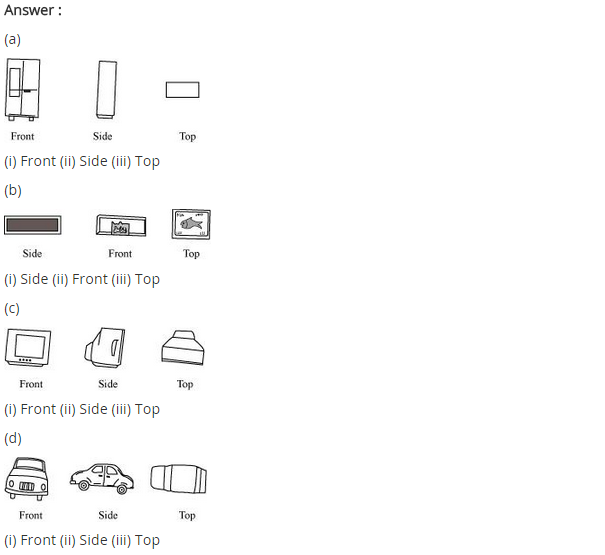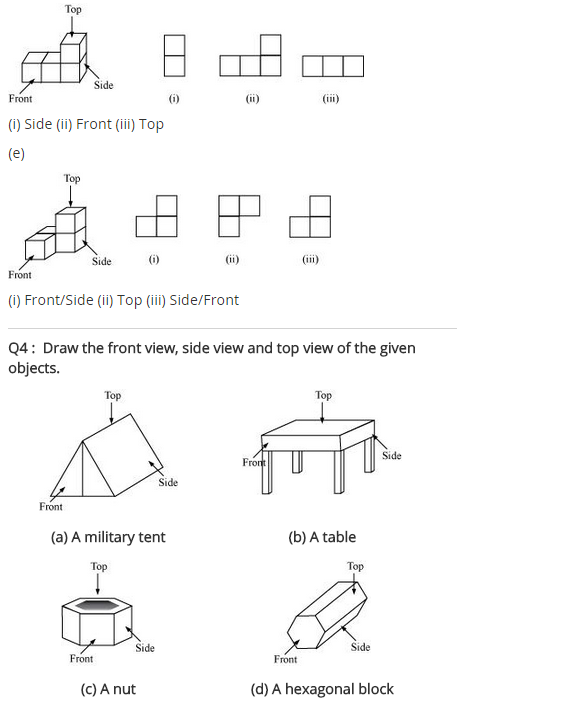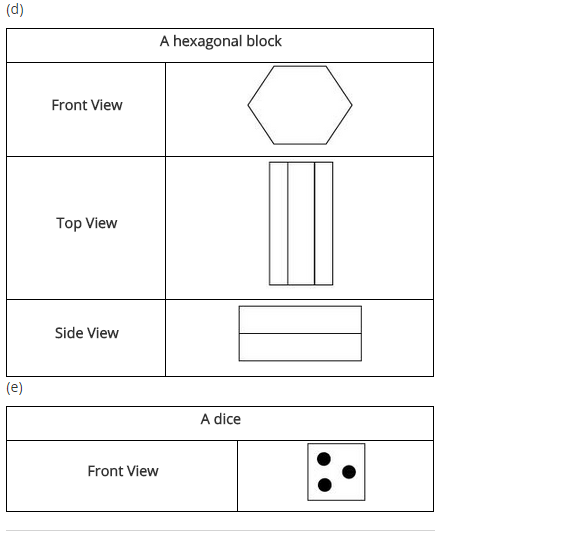NCERT Class 8 Maths Chapter 10 Visualising Solid Shapes Ex 10.1 Solutions
NCERT Solutions for Class 8 Maths Chapter 10 Visualising Solid Shapes Exercise 10.1
Ex 10.1 Class 8 Maths Question 1.
For each of the given solid, the two views are given. Match for each solid the corresponding top and front views. The first one is done for you.
Solution:
(a) A bottle → (iii) → (iv)
(b) A weight → (i) → (v)
(c) A flask → (iv) → (ii)
(d) Cup and saucer → (v) → (iii)
(e) Container → (ii) → (i)
Ex 10.1 Class 8 Maths Question 2.
For each of the given solid, the three views are given. Identify for each solid the corresponding top, front and side views.

Solution:
(a) An Almirah → (i) Front → (ii) Side → (iii) Top
(b) A Match box → (i) Side → (it) Front → (iii) Top
(c) A Television → (i) Front → (ii) Side → (iii) Top
(d) A Car → (i) Front → (ii) Side → (iii) Top
Ex 10.1 Class 8 Maths Question 3.
For each given solid, identify the top view, front view and side view.

Solution:
(a) (i) Top → (ii) Front → (iii) Side
(b) (i) Side → (ii) Front → (iii) Top
(c) (i) Top → (ii) Side → (iii) Front
(d) (i) Side → (ii) Front → (iii) Top
(e) (i) Front → (ii) Top → (iii) Side
Ex 10.1 Class 8 Maths Question 4.
Draw the front view, side view and top view of the given objects.
Solution:












Class 8 Maths Chapter 10 Visualising Solid Shapes Ex 10.2
NCERT Class 8 Maths Chapter 10 Visualising Solid Shapes Ex 10.2 Solutions
NCERT Solutions for Class 8 Maths Chapter 10 Visualising Solid Shapes Exercise 10.2
Ex 10.2 Class 8 Maths Question 1.
Look at the given map of a city.
Answer the following.
(a) Colour the map as follows: Blue-water, red- fire station, orange-library, yellow-schools, Green-park, Pink-College, Purple-Hospital, Brown-Cemetery.
(b) Mark a green ‘X’ at the intersection of Road ‘C’ and Nehru Road, Green ‘Y’ at the intersection of Gandhi Road and Road A.
(c) In red, draw a short street route from Library to the bus depot.
(d) Which is further east, the city park or the market?
(e) Which is further south, the primary school or the Sr. Secondary School?
Ex 10.2 Class 8 Maths Question 2.
Draw a map of your classroom using proper scale and symbols for different objects.
Ex 10.2 Class 8 Maths Question 3.
Draw a map of your school compound using proper scale and symbols for various features like a playground, main building, garden etc.
Ex 10.2 Class 8 Maths Question 4.
Draw a map giving instructions to your friend so that she reaches your house without any difficulty.
Solution:
Question 1 to Question 4 each all activities. You can try yourself.



Class 8 Maths Chapter 10 Visualising Solid Shapes Ex 10.3
NCERT Class 8 Maths Chapter 10 Visualising Solid Shapes Ex 10.3 Solutions
NCERT Solutions for Class 8 Maths Chapter 10 Visualising Solid Shapes Exercise 10.3
Ex 10.3 Class 8 Maths Question 1.
Can a polyhedron have for its faces
(i) 3 triangles?
(ii) 4 triangles?
(iii) a square and four triangles?
Solution:
(i) No, because polyhedron must have edges meeting at vertices which are points.
(ii) Yes, because all the edges are meeting at the vertices.
(iii) Yes, because all the eight edges meet at the vertices.
Ex 10.3 Class 8 Maths Question 2.
Is it possible to have a polyhedron with any given number of faces?
(Hint: Think of a pyramid)
Solution:
Yes, it is possible if the number of faces is greater than or equal to 4.
Example: Pyramid which has 4 faces.
Ex 10.3 Class 8 Maths Question 3.
Which are prisms among the following?
Solution:
Only (ii) unsharpened pencil and (iv) a box are the prism.
Ex 10.3 Class 8 Maths Question 4.
(i) How are prisms and cylinders alike?
(ii) How are pyramids and cones alike?
Solution:
(i) If the number of sides in a prism is increased to certain extent, then the prism will take the shape of cylinder.
(ii) If the number of sides of the pyramid is increased to same extent, then the pyramid becomes a cone.
Ex 10.3 Class 8 Maths Question 5.
Is a square prism same as a cube? Explain.
Solution:
Every square prism cannot be cube. It may be cuboid also.
Ex 10.3 Class 8 Maths Question 6.
Verify Euler’s formula for these solids.
Solution:
(i) Faces = 7
Sides = 15
Vertices = 10
Euler’s formula: F + V – E = 2
⇒ 7 + 10 – 15 = 2
⇒ 2 = 2
Hence, Euler’s formula is verified.
(ii) Faces = 9
Sides = 16
Vertices = 9
Euler’s Formula: F + V – E = 2
⇒ 9 + 9 – 16 = 2
⇒ 2 = 2
Hence, Euler’s formula is verified.
Ex 10.3 Class 8 Maths Question 7.
Using Euler’s formula find the unknown.
| Faces | ? | 5 | 20 |
| Vertices | 6 | ? | 12 |
| Edges | 12 | 9 | ? |
Solution:
| Faces | 8 | 5 | 20 |
| Vertices | 6 | 6 | 12 |
| Edges | 12 | 9 | 30 |
Using Eulers Formula: F + V – E = 2
Ex 10.3 Class 8 Maths Question 8.
Can a polyhedron have 10 faces, 20 edges and 15 vertices?
Solution:
Here faces = 10, Edges = 20, Vertices = 15
According to Euler’s Formula:
F + V – E = 2
⇒ 10 + 15 – 20 = 25 – 20
⇒ 5 ≠ 2
A polyhedron do not have 10 Faces, 20 Edges and 15 Vertices.






NCERT Solutions for Class 8 Maths
- Chapter 1: Rational Numbers
- Chapter 2: Linear Equations in One Variable
- Chapter 3: Understanding Quadrilaterals
- Chapter 4: Practical Geometry
- Chapter 5: Data Handling
- Chapter 6: Squares and Square Roots
- Chapter 7: Cubes and Cube Roots
- Chapter 8: Comparing Quantities
- Chapter 9: Algebraic Expressions and Identities
- Chapter 10: Visualising Solid Shapes
- Chapter 11: Mensuration
- Chapter 12: Exponents and Powers
- Chapter 13: Direct and Indirect proportions
- Chapter 14: Factorisation
- Chapter 15: Introduction to Graphs
- Chapter 16: Playing with Numbers


